Intro Refreshed EVGA EPOWER V "The Untouchables" stand-alone power board returns. It's been some time since release of the
previous Gen 4 model in 2013. EVGA EPOWER module is handy and versatile tool to provide more juice to various graphics adapters, especially physically and power constrained reference designs from NVIDIA and AMD. This is crucial for extreme overclocking with liquid nitrogen cooling.
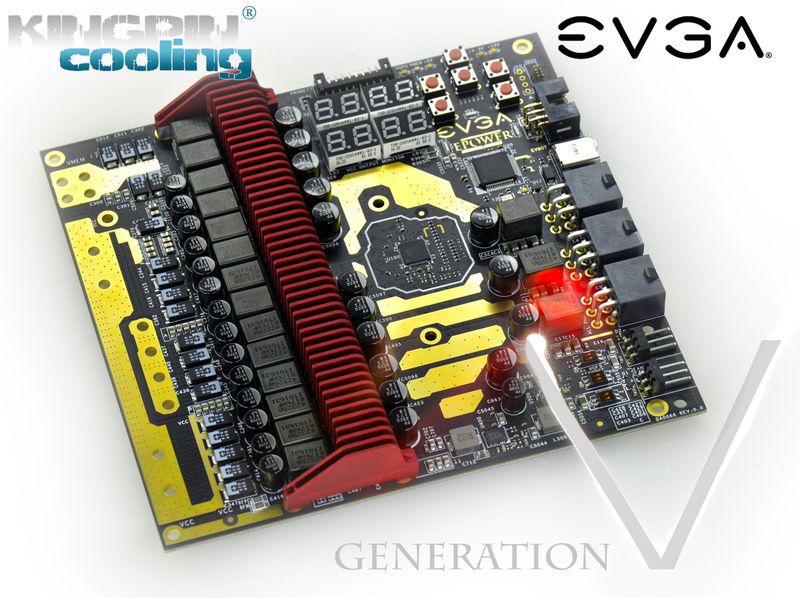
This is fifth version of the EPOWER project, released in retail for extreme overclockers and hardcore enthusiasts. It gets the label "Generation V" for this reason. Previous EPOWER Gen 4 Classified with blood red PCB resembled
EVGA GeForce GTX 680 Classified power solution. New EPOWER V leverage more efficient and higher power VRM from
EVGA GeForce GTX 980Ti K|NGP|N Edition card. VRM was further tuned up with latest IR3575/IR3579 Infineon PowerStages that have improved thermal performance.
EPOWER V has synchronous buck DC-DC converter with no less than 12+2 phase layout. Such converter use input +12VDC voltage from standard PC PSU to provide stable and regulated 0.6 - 2.0V output voltage, at maximum loading over 600 Amp. Additional 2 phase DC-DC regulator used for second voltage rail channel, with individual control and current capability up to 90 A. Second channel can be used for memory power on graphics card or PEX/PLL power.
Since different VGA cards may require different output voltages, both settings are adjustable in real-time. In this article we will cover common use scenarios and possible ways to adjust voltage, protection limits and other available tweaking knobs.
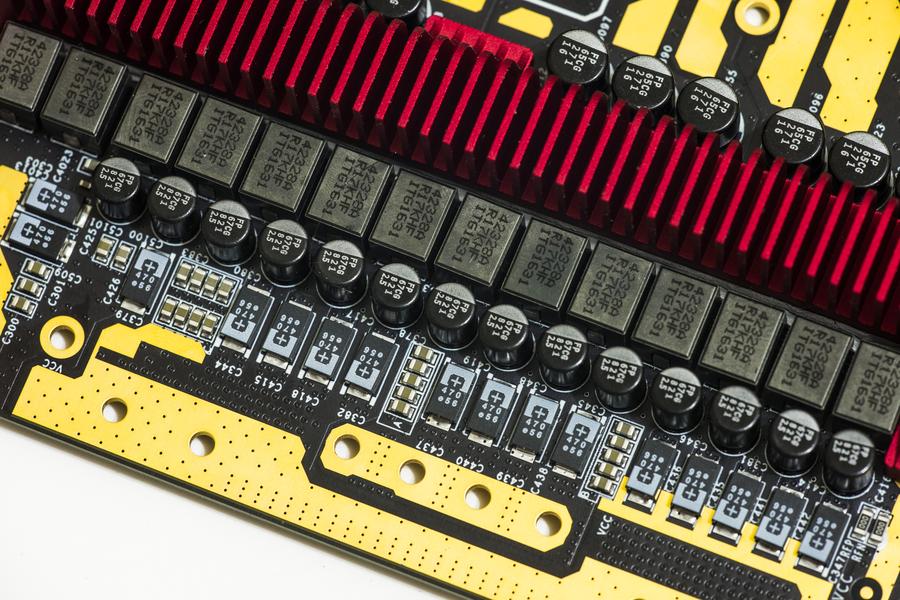
As with previous EPOWER's, connection to target graphic card is done by direct soldering with heavy gauge copper wire, or better, solid copper plates. Due to high currents and low voltages, it is essential to have minimal resistance at interconnect between the VGA card and EPOWER. Wide and short connection is the main rule here.
Due to complexity of use, EPOWER V is covered only by special DOA(Dead-on-arrival) type warranty. Meaning that every single EPOWER is tested before shipment and can be replaced only if it's not working out of the box, with only ATX PSU attached to it. If you modified your VGA, soldered EPOWER down, there will be no replacements possible. Be sure to check EPOWER correct output prior to connecting it with VGA card. Disclaimer Before we dig deep into details, here's required part:
Redistribution and use of materials in this article or any files referenced in it, in source and binary forms, with or without modification, are permitted provided that the following conditions are met:
* Redistribution of article must retain the above copyright notice, this list of conditions, link to this guide (
https://xdevs.com/guide/epower_v/) and the following disclaimer.
* Redistribution of files in binary form must reproduce the above copyright notice, this list of conditions, link to this guide (
https://xdevs.com/guide/epower_v/), and the following disclaimer in the documentation and/or other materials provided with the distribution, for example Readme file.
All information posted here is hosted just for education purposes and provided *AS IS*. In no event shall the author, this site, or any other party, including EVGA be liable for any special, direct, indirect, or consequential damages or any damages whatsoever resulting from loss of use, data or profits, whether in an action of contract, negligence or other tortuous action, arising out of or in connection with the use or performance of information published here.
This product is intended for use by advanced users with good understanding of computer parts function, decent soldering skills and experience in extreme overclocking. There is no benefit to use such device for everyday gaming, as native VRM on the graphic card is a good match for everyday use cases. If you do not agree with risks involved, do not perform the any modifications.
EVGA EPOWER V theory and design Before we start any soldering and testing let’s take brief tour into typical VRM (Voltage-Regulation Module) design. VRM is a device, usually in form of circuitry on PCB which consist of
DC-DC converter and controller, which provides a load the appropriate power supply voltage. This is achieved by using
switching regulator that convert high input voltage (such as +12.0 VDC from PCIe power cable) to a much smaller voltage level required by the load specifications. Since the total power is the same, lower voltage allow to source much higher currents, used by all those billions of transistors inside the CPU/GPU.
Load here and further in article meaning target device, such as central processor on motherboard or GPU(Graphics Processing Unit)) on graphics card. From power supply point of view, it doesn't matter what is used as load, it could be even piece of heating wire. Common and important thing is that load sink provided current, depending on its dynamic and static internal resistance. Task of VRM is to provide that current and regulate output voltage stable, with any changing load conditions.
Why not to supply already regulated lower voltage from the PSU directly? Answer to that question is resistance of interconnects and power loss on wires. Modern GPU can easily sink over 200 A of current, which means use of very heavy gauge wires. Since GPU also have strict voltage regulation demands (usually 5% or better) there is no way to provide that much of current with any reasonably sized (and priced) wires or connectors to lengths over few centimeters (inches). That's why any typical motherboard or graphics card has these switching DC-DC converters onboard, right next to CPU/GPU. Sometimes VRM are installed as daughter boards in a dedicated high-power connector (common to see such VRM modules in rack servers, where every inch of space is vital).
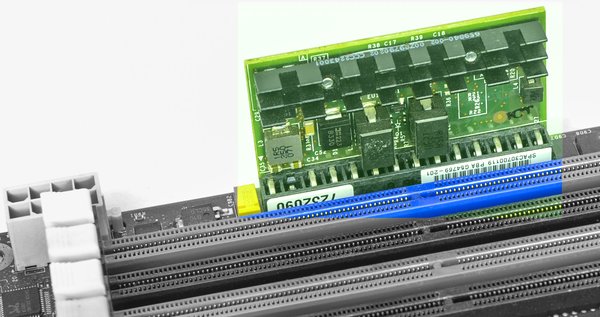
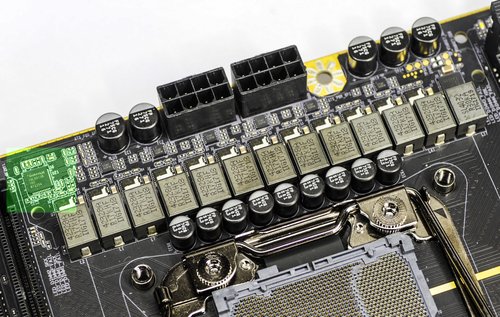
It is easy to recognize power regulator circuit by proximity with high-current ferrite inductors and banks of capacitors. Multi-phase regulators have all phases grouped together, to maintain current and thermal balance across phases. Proper spacing to rest of the sensitive circuitry on the PCBA (memory, I/O interfaces or onboard controllers) is implemented due to large amounts electrical noise generated by switching components in VRM.
Some voltage regulators provide only one fixed level supply voltage to load, but most of them can provide mechanism to adjust the supply voltage from the load using some form of interface, be it parallel VID signals, or even simple analog feedback circuitry. Multi-phase VRMs that designed for modern CPU or GPU power also can use dedicated digital bus, such as I2C/SMBus/PMBus or SVID/PWMVID to get necessary data for operation and reporting.
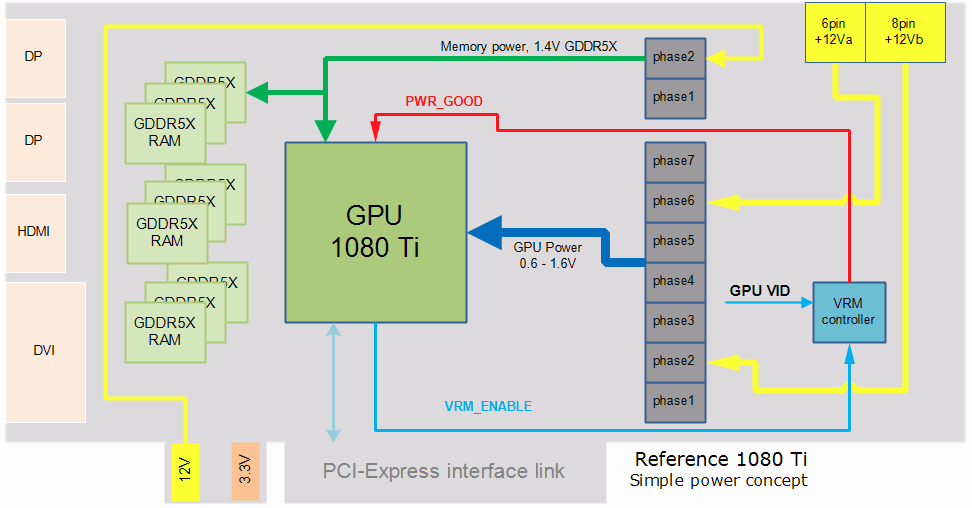
Image above show typical high-level VRM map of VGA card. Ignoring number of phases and type of connectors, every VGA card is build this way. Two important logic signals, VRM_ENABLE and PWR_GOOD are discussed in next chapter.
VRM controller also needs its own power supply voltage to operate. This is usually system auxiliary low-voltage rail, such as +3.3 VDC from the PCI-express edge connector. +3.3V voltage is used for digital domain of VRM, like PWM controller, onboard clock generation, control circuits and various onboard logic. +3.3VDC often used by other controllers and I/O devices, SLI interface power, BIOS, hardware health monitors, I/O detection logic and such. That's why PCI-Express CEM standard for AIC(Add-In Card) always have +3VDC and +12VDC power inputs at PCI-Express slot edge connector. +12V used for lower power DC-DC and +12V from separate 6/8-pin power cable from PSU.
In this article we will study few examples of VRM circuits and will learn few things how to use, control and override these converters. EPOWER V is a great example to learn all related knowledge. This is especially important for overclocking and performance testing, as voltage margining can act as the key for higher frequencies.
Many controllers allow shutdown control and power good status reporting. For that dedicated GPIO signal line and pins are used. Such signals described as "ON/OFF" or "VR_Enable" or simply "Enable" signal and power good status reported via "VR_RDY" or "PWR_OK" signal/pin.
Enable signal in VRM operation Purpose of VRM_ENABLE signal is to provide ability to turn on (Enable) or off main VRM by our GPU or other smart monitoring circuitry that may be present onboard. This signal has *input* direction, feeding signal into VRM controller. Let's take simple example in term of generic 1080 Ti videocard depicted on _Image 4_ above. 1080 Ti GPU used on this card have special GPIO pin hooked to VRM_ENABLE signal on PWM. During startup I/O block of 1080 Ti chip pulls this signal high, thus giving command for VRM to start operation and power-up. VRM begin to operate at nominal level, which is around 1 VDC output. Once output reached stable regulated level, VRM controller activates PWR_GOOD signal, which is often tied to GPU's RESET input, and let GPU start initialization and boot. If for whatever reason PWR_GOOD is not active (stay low level, 0V) then GPU will be kept in RESET condition and will not boot.
Why we need such arrangement, and not let VRM to start and run on its own. This "ENABLE" handshaking between GPU and power regulator allow to implement protection mechanism, for example overheating protection. Assume that user forgot to connect fans on cooler, resulting critical GPU overheat while VRM operation continue to power the chip. VRM still feeding GPU with nominal voltage, as it can't know anything about GPU temperature. GPU will cook itself to death short if no action taken quick.
However, during overheat event GPU chip can sense its temperature and forcefully pull down VR_ENABLE pin to 0 V. As result of this VRM now will immediately shut down output voltage, as result preventing possible damage to graphics card GPU. Do not confuse this with other software-controlled shutdowns or protection triggers, such as OCP or OVP trip, which are internal to VRM. Protection trips are detected by VRM controller internally, and are not related to external logic. Such events can be reported by PWR_GOOD signal.
VR_ENABLE can be also controlled by simple detector logic circuitry based on small NPNs or NFETs to always enable VRM if input power voltage +12V or +3.3V rail voltage from PCI-Express slot is present. This is why if you don’t have +3.3V/+12V power on PCIe slot VRM will be permanently disabled no matter which voltage we give to PCIe 6-pin power connectors.
Power good signal from VRM Now few words about *VR_RDY* (Voltage regulator Ready) or *PWR_GOOD* (Power Good) signal. In a way it has reversed meaning of VRM_ENABLE. This signal is *output* direction, from VRM controller. When this signal is active high, VRM is reporting normal operation, with stable and controlled output voltage, at rated settings, currents and temperatures. This is often used in high-end cards to monitor state of VRM to detect faults and assert shutdown before critical failures progress further. For example, if MOSFET in phase blows up, VRM see that phase current levels reach critical limits and reports failure to system dropping PWR_GOOD. Similar method is used in usual ATX PSUs btw, by signal Power Good.
Now let's take a look on same block diagram, but with GPU power coming from EPOWER.
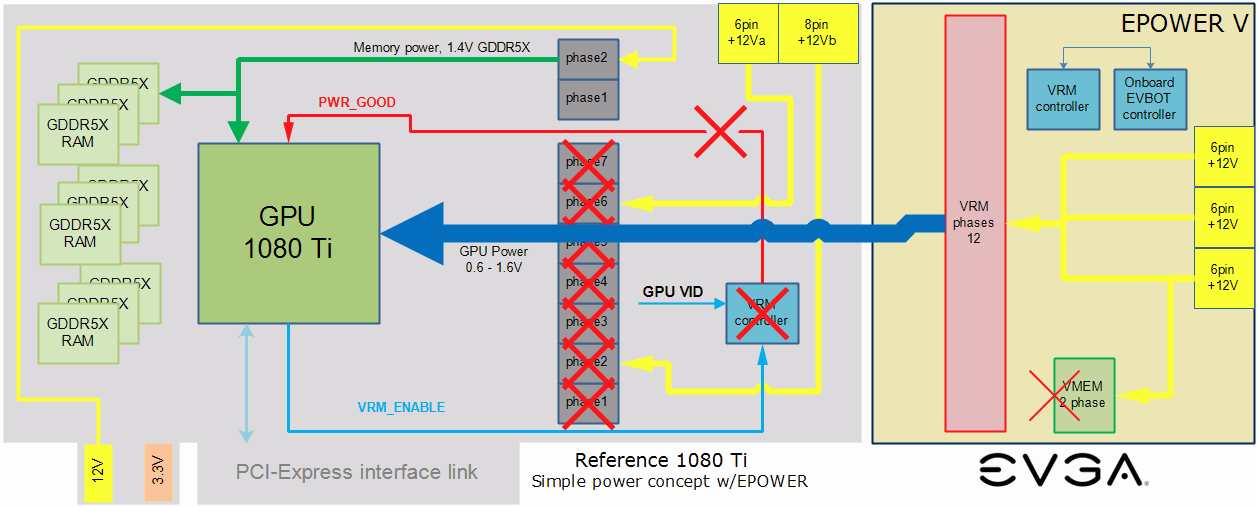
Standalone power supply module, such as EVGA EPOWER V is designed to replace onboard VCORE regulator too allow higher capacity power delivery. This is beneficial for extreme overclocking use, as onboard DC-DC power converters on reference design are often not adequate for high voltage/high loading Extreme OC scenario. Often onboard regulators also lack of adjustment range, so you may be limited to lower voltage, than actual GPU can run before having thermal/stability issues.
While isolated supply module gives us flexibility, it also does not come free. Difficulty of running card with EPOWER is due to inherent lack of sync between onboard VRM controller and EPOWER's controller, as these are two separate controllers. So typical solution is to completely disable onboard VRM, isolate it from GPU and use EPOWER instead.
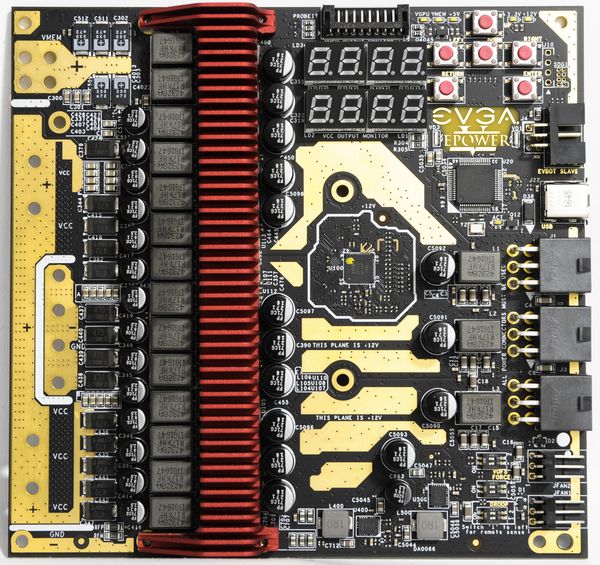
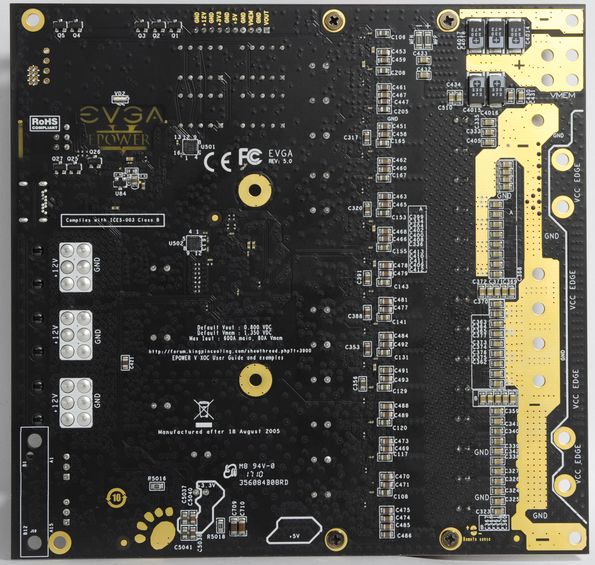
Same as Gen 4, board accepts input voltage from triple MiniFit Jr. 6-pin connectors, following typical PCIe VGA pin out. Input voltage range is +10.6 to +13.2 VDC, easy requirement for any high-end 1000+ Watt ATX PSU. For heavy loading, such as Titan Xp + EPOWER at least 1200 W single-rail PSU is recommended.
EPOWER V has two four-digit LED displays, which indicate current voltage on both channels. On key press setting value for output voltage is displayed. More on controls later in this guide.
Latest generation is also more flexible now, in terms of use and hardware support. Firmware can be reprogrammed by user to allow special cases, when additional features or functions, such as protection, loadline tuning or monitoring are required. This may be crucial for overclocking modern cards, such as AMD Fury/Vega or NVIDIA Titan X/Xp. Additional firmwares will be made available thru this guide or in this thread.
EPOWER V using Infineon VRM controller,
IR3595A. Key feature list:
* 8-phase single or 6+2 dual loop configurable PWM Controller. Here it's used as 6+1 dual loop.
* 8-bit PVID, PWM VID or I2C set point control on loop 1
* Serial I2C set point control on optional loop 2
* Programmable Constant Current Protection
* Min/Max Telemetry registers and real-time monitoring via I2C (IIN, VIN, IOUT, VOUT, Temp)
* IR Adaptive Transient Algorithm (ATA) minimizes output bulk capacitors and system cost
* IR Efficiency Shaping Features including Variable Gate Drive and Dynamic Phase Control
* Protection: OVP, UVP, OC Warn, OCP, OT Warn, OTP
Loop in power terminology here is referred to output voltage channel. Due to safety reasons, maximum output voltage is limited around 2.000V. Most modern VGA cards have capacitors on Vcore rated only up to 2.000V, and will max out overclocking at much less voltage, even under liquid nitrogen -196 °C cooling. Solid capacitors may have nasty explosions and fire if overvoltage happens, so voltage limits greatly reduce this risk.
EPOWER board can be a very handy tool for new GPU testing, as it can be used the moment we get the reference cards for overclocking. Based on those test results, not limited by power constrains of voltage limits, finalized custom designs like KINGPIN Edition and FTW3 emerge, which essentially have both EPOWER and GPU circuitry already integrated on the same PCB, without any mess and wires.
Also onboard controls are added, so no external EVBOT dongle required to get voltage readout of real-time voltages on both VCORE and VMEM rails. Output voltages can be also freely adjusted at any time by onboard keypad.
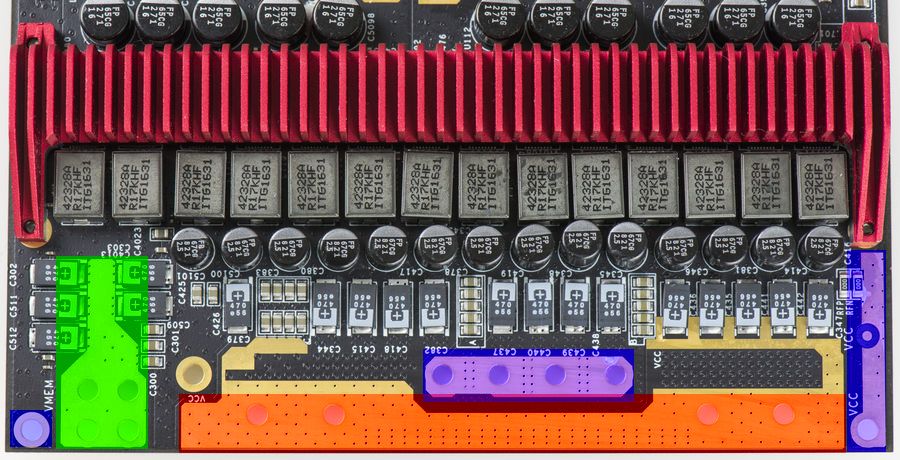 Feature overview
Feature overview Here's quick fact sheet with main features list on this latest generation EVGA EPOWER V VRM.
Dual-channel powerful output EPOWER Gen 5 can source over 620A of current with typical output voltage 1.6-1.8V. Maximum voltage available is 2.0V on main VCORE output. Additional memory VMEM channel supports voltages up to 2.3V and source current up to 90A. Remove sense option is available for both rails to obtain accurate voltage regulation.
Onboard voltage LED display and integrated EVBOT function 
Previous generation EPOWER required external controller for real-time voltage adjustment, one of which is EVBOT. Today just few overclockers have EVBOTs, so to address this new EPOWER have onboard fully integrated controller, which allow adjustments of both voltage output channels in real-time. Voltage readouts are calibrated to DC accuracy better than 3%.
Embedded self-diagnostics On each power up onboard controller checks all voltages, test interface operation for VRM controller and verify input signals. This takes just a moment and result of diagnostics briefly displayed on the screen. In normal conditions you should just see brief "TEST PASS" message.
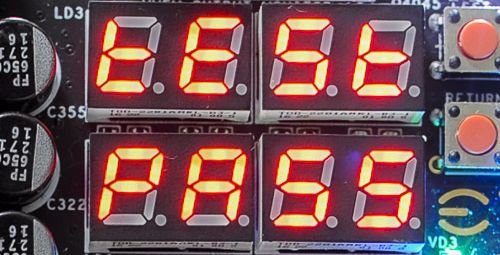 Future-proof USB-C interface
Future-proof USB-C interface Onboard USB Type-C connector provide interface between EPOWER and host PC. This allow to field firmware upgrades, to support upgrades and compatibility with new graphic adapters. Update procedure is simple and involve just USB A-C cable to computer.
 ProbeIt monitoring header
ProbeIt monitoring header Standard connector to attach external multimeter or oscilloscope for spot checks and operation monitoring. Output VCORE, Output VMEM, Onboard +3.3V, +5 and input +12V voltages are routed to ProbeIt, interleaved with ground return terminals.
Output voltage status also displayed by on-board white LED, just like
EVGA GeForce GTX K|NGP|N Edition series cards.
Fan headers 
Typical use case requires minimal airflow at EPOWER's power circuits. Onboard +12V 3-pin support two fans. There is no PWM control, and fans will run 100% speed once connected to EPOWER. Unlike typical motherboard fan headers, each of EPOWER headers support high-speed high-power fans for system cooling, up to 3 A each.
Droop, Force and Offset voltage HW switches Few advanced hardware controls available for power users. Offset switch *VOFS* bumps VCORE output voltage 80mV/switch, adding max voltage of 0.16V to the present value. This is independent control, handy is you needed higher boot voltage on system power on.
*Force* switch disable protection mechanisms to force power output, even when EPOWER overloaded.
*Droop* controls compensation and remote sensing operation. This is important function to compensate for voltage droop on high-power VGA's, such as 980Ti or Titan X (Pascal).
Triple 6-pin power inputs EPOWER V does not allow hot-plugging, hence there is no detection pin required. As result all three pairs +12V ATX PCIe Power connector, which is 6-pin MiniFit.Jr type are available as power input. Such connector configuration support 33A 12V, using typical 16AWG cables from high-end computer power supply. This is based on rather conservative +30°C temperature rise over ambient for the connector pin. In typical system, with forced airflow from cooling fans, three 6-pin connectors allow 100A+ input currents. Simple napkin power math calculation helps to understand available power budget easy:
PMAX = IMAX * V12V; PMAX = 100A * 12.0 VDC = 1200 W MAX Where *PMAX* is maximum input power, *IMAX* current rating and *V12V* is input voltage from the system power supply. With help of IR3575 PowIRstage(R) Datasheet VRM efficiency can be estimated at level ~90%, with 94% peak at 216A load. However typical use of EPOWER will be at full loading, so calculation below is for worst case.
POUT = PMAX * 89% efficiency;* POUT = 1068 W; IOUT = POUT / VOUT; IOUT = 1068 W / 1.65 VDC = 647 ADC
Where *POUT* is available output power with VRM efficiency in math, *IOUT* available current rating and *VOUT* typical output voltage, chosen in math above to be equal 1.65VDC. Now we can also estimate power loss on conversion.
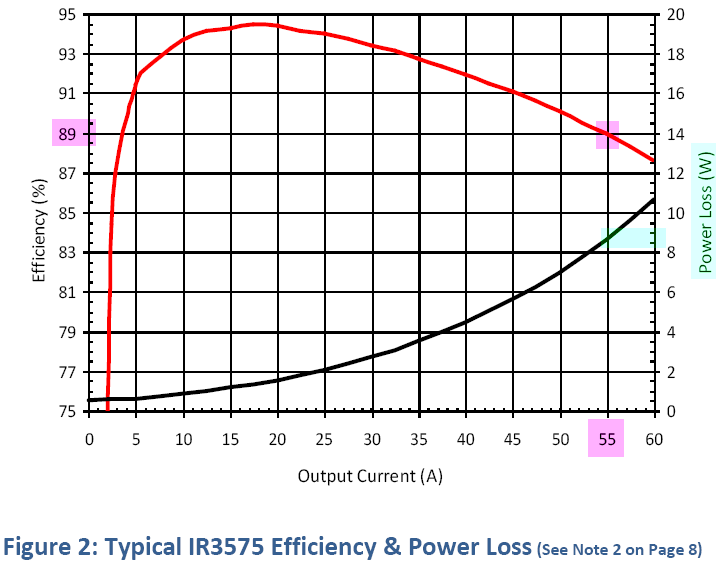
At output current 647 A regulator will have 55 A per phase, which cause *9 W* of power loss per phase. With total phase number equal 12 for main VOUT rail that is *9 W × 12 V = 108 W*. Such power level mandate active airflow. If heatsink and PCB kept cool, IR3575 power stage silicon die temperature can be calculated using datasheet's *θJC_TOP* thermal resistance specification.
*Die ΔTrise = PLOSS * θJC_TOP;* Die ΔTrise = 9 W * 1.7 °C/W = *+15.3 °C*.
With ambient temperature +30 °C die temperature will reach only +46°C, if heatsink kept at same temperature. In more realistic case, heatsink will have 30-40 °C temperature rise, which is within safe margins for IR3575 specification of TJMAX = +150 °C.
This calculation is essentially same for every DC/DC design converter, and it's good idea to practice it for better understanding of power derating and importance of high efficiency. Such math applies to motherboard, graphic card VRMs and even ATX power supplies, if all used component specifications are known. Suggest to run own numbers with different output voltages/currents to match your case. All three power input connectors must be plugged, as phase power balancing is done in hardware to sink current equally from each connector. Good airflow over the board is highly recommended for optimal performance with higher power levels.
EPOWER V Usage methodology Detailed step-by-step guide in this section show typical use scenario for EPOWER V. Following the guide can help you achieve best results with this extreme overclocking product. Older guides can be used as reference as well, the overall concept and application remain the same.
To use external power regulator board, such as EPOWER V successfully follow next set of rules:
* Think carefully about the end ultimate goal, carefully and in detail. Modern graphics card VRM solutions become much better over last few years, and totally sufficient for normal use, gaming, even overclocking on water-cooling. However, to overclock card to the ultimate limit under subzero cooling with CO2 dry ice or LN2 liquid nitrogen, you may quickly run into power issues, and that's where you consider using EVGA EPOWER V. So plan properly. It's very unlikely that anyone would buy VGA card which was subjected to heavy PCB modifications, required to use EPOWER.
* Every power wire should have short return path wire for current. Good idea to have two return wires for every power wire. Electricity flow in closed loop circuit, using *TWO* wires, forward (positive VRM output) and return (GND or ground zero). This is why you always have two contacts in your home mains power outlet, not one, but two (for simplicity, earth terminal is omitted, it carries electric current only in critical failure condition).
* Keep things simple. Do not do stuff you don't understand completely. Practice on something easy and cheap before starting complex things, and practice first on low-end old graphic cards, which you don't care much about. Once you have solid skills to apply all required mods, proceed with higher end equipment with better skillset.
* Keep high-power paths and connections length SHORT and WIDE. More length – more voltage drop, more EMI pickup, more noise from power regulator. So lots of headache with long wires is a guarantee. This is why all power connection on VGA, Motherboards, CPU boards whatever are made with solid copper planes, to have shortest path possible for all those large currents. I would not use anything less than AWG14 for such high-power low-voltage VRMs. This rule also suggests to connect wires as close to load as possible. Usually nearest comfortable spot to connect is original VRM choke contact, from load side. You will anyway have to desolder chokes, so you already have nice solder point to start with there anyway.
5. Remember, electronics is a science about contacts. No contact where it should be – failure. Contact where it should not be – failure. Recheck and check every step of the process as you progress to get successful results. Never power up anything until it is fully checked every component and every connection. Remembering that you have only one GPU to blow up in case something goes haywire may help. These checks might feel like waste of time, delaying overclocking session by hours, sometimes even days, but it’s actually saving time, money and hardware (not by burning it, or making awful results) in long term.
Uncorking BIG KELPER - practical guide for beginners Using EPOWER Gen.2 on GeForce 8600 GTS card KPC: Zombie EPOWER Titan Guide STEP 1 - Prepare workbench area and gather all required tools * Target device, in our case
EVGA GeForce GTX 1080 Ti reference graphics card
* EVGA EPOWER V power module
* AWG12 or AWG10 copper wire with insulation or copper plates
* High power soldering iron,
120W+ recommended for copper plates
*
Generic digital multimeter for resistance and voltage checks
* 80/120mm +12V DC FAN with 3-pin header for VRM cooling
* Some
flux and
solder for wire joints
* Insulation materials to prevent moisture on VRM
* Sharp blade to prepare insulation
* LN2 extreme cooling container for GPU cooling, such as
Kingpincooling.com TEK-9 FAT Many enthusiasts and overclockers already have most of the items from this list, only new thing - copper plates. I found them to work best than heavy gauge wires, because they are not flexible and less troublesome to keep in fixed position. However, they have large thermal mass, and need high power soldering iron, at least 120W. I use high-power
ERSA iCON 1 soldering station. Also copper plates after shaping can be reused for multiple cards. Also no burning wire insulation and nasty smoke from plates, which is better for overclockers health.
Suggest to perform all modifications with good bright lights, so you can see clearly what is going on. Some additional gear, like pliers, magnifying glass, set of wires could be useful on various steps. Taking few photos during the process may help later to showcase the result in your benchmark submissions

.
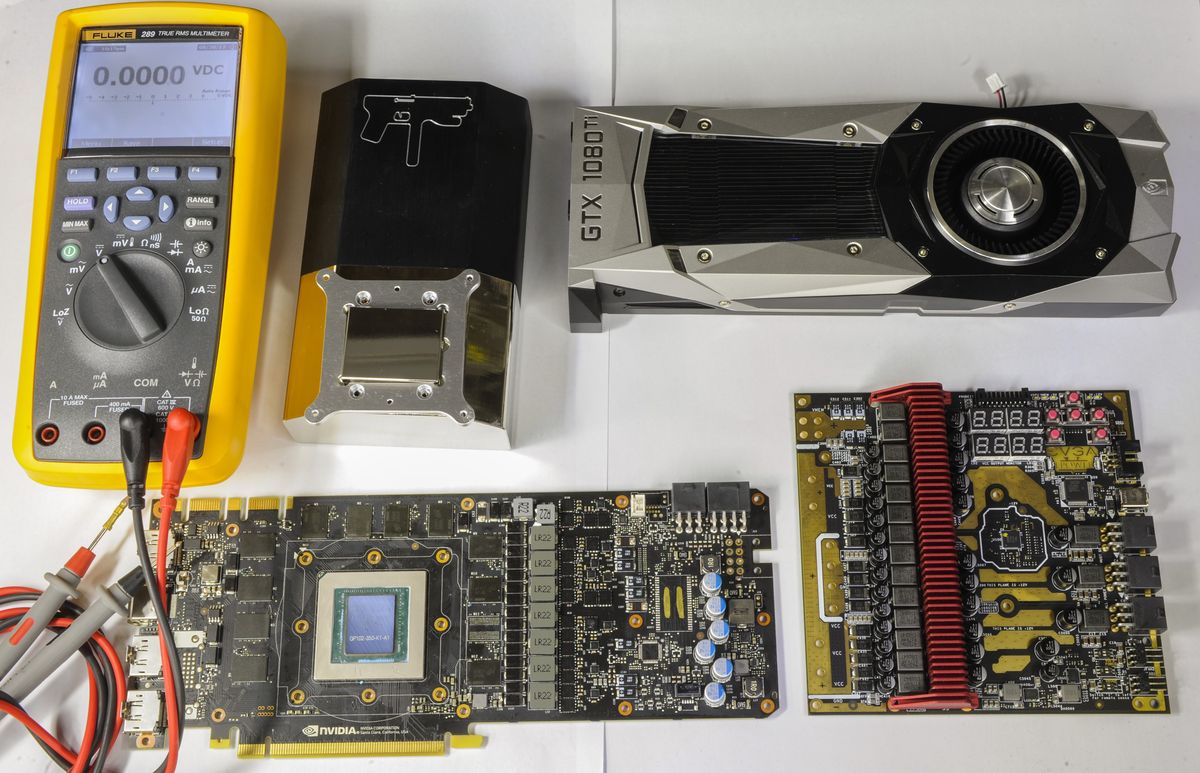
One can buy these copper sheets at local PC cooling parts shop, but pretty sure those are not hard to get all over the world in some metalwork shops, etc. Thick copper foil (0.5-1.5mm thickness) would work too, just combine few sheets together to provide nice robust plane.
When carving copper plane shapes, ensure the plane shapes are reasonably square in shape. Avoid having a long and narrow plane shape because this limits the current flow and increases plane parasitic inductance and loss.
STEP 2 - Remove onboard VRM inductors Remove heatsink from the VGA card. It's easy to locate power regulation circuitry on the videocard.
You can overlay EPOWER to estimate best placement on the card. It is important to keep shortest distance possible between EPOWER output exposed metal area and VGA card VRM power inductors. Short and wide connection allow better voltage regulation and stability.
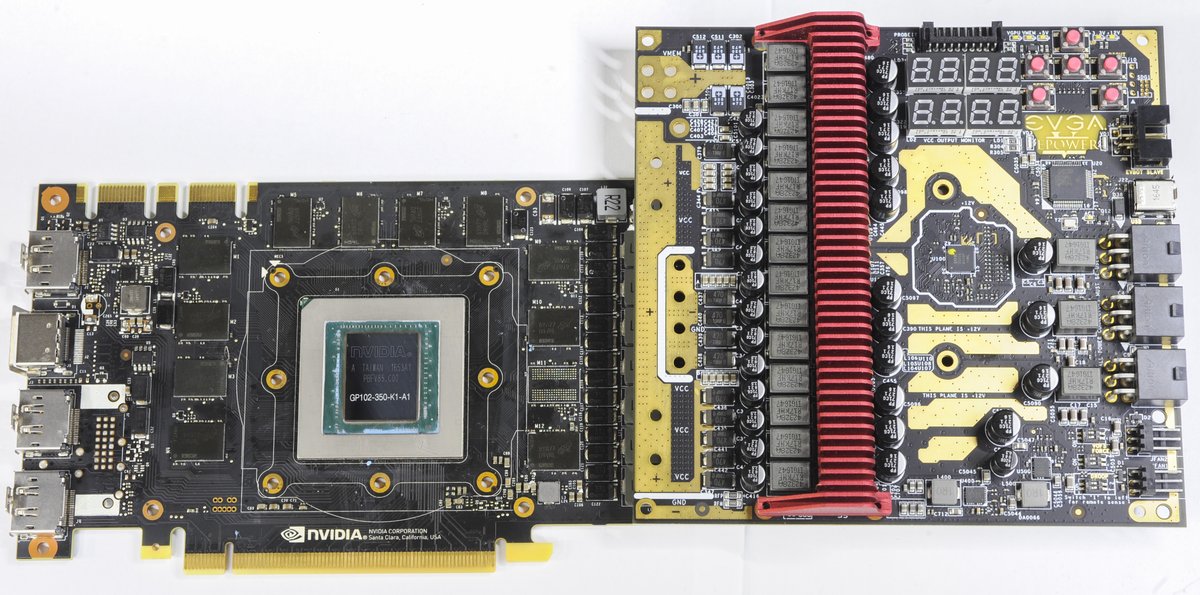
Main GPU VRM circuitry usually located on the right side PCB, between GPU and power input connectors. It's easy to spot one by location of big high-power inductors, which look like gray rectangles with two massive contacts. Now since our goal is to replace onboard power regulation circuit with EVGA EPOWER V module, we need to isolate onboard regulator, and expose copper to have clean power entry path.
At this point you can also check how much space is required for your GPU cooling solution. It would be a sad moment, if all the work done only to find out 2 mm interference with the LN2 container preventing setup from assembly.
Removing inductors (marked R22 Power choke) will do exactly that, disconnect GPU power input from the onboard VRM and leave large area with metal plane to allow EPOWER connection. That's where output of the EPOWER VRM will be connected once we find best spot for whole assembly.
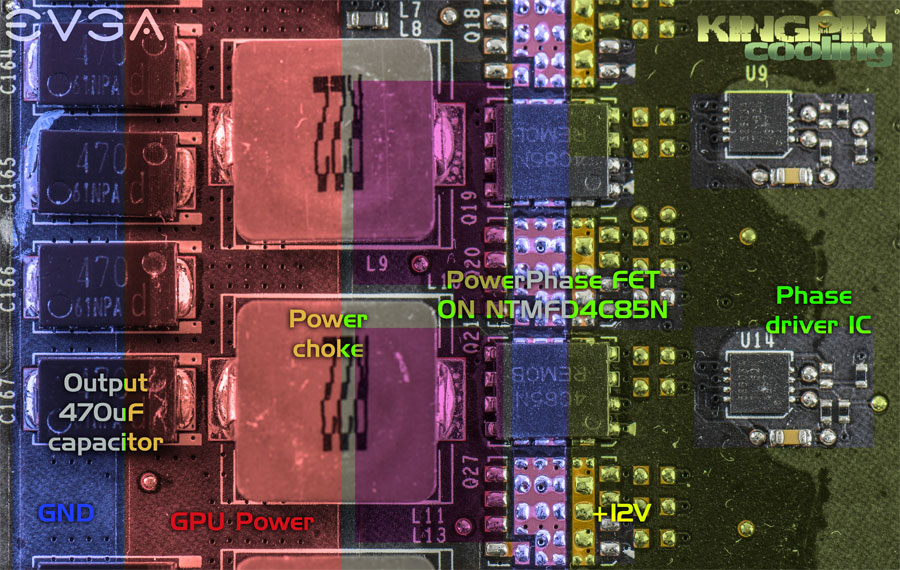
Desolder original inductors of each GPU voltage phase with high-power soldering iron. On GeForce GTX 1080 Ti there are 7 inductors, marked LR22. Leave smaller R22 inductor near top edge of the board intact, that one is used for separate memory VRM circuitry.
One side of inductor pad go to VRM MOSFET stage by rather big polygon (solid copper plane) and opposite side connected across all output inductors, array of power filter output capacitors and enter internal layers to provide solid connection to GPU power pins. Idea of using EPOWER is follow same concept, so we need to connect power output from EPOWER V PCB to this output capacitor polygon as good as possible, thus having power flow into original power planes from external source.
Usually good idea to keep memory power delivered from onboard regulator. Typically, you would need memory attached to EPOWER only on older cards, or dual GPU cards to avoid power balance issues. If you decide to have memory powered from EPOWER V as well, remove memory power inductors too.
Now need to take care of *PWR_GOOD* signaling.
STEP 3 - Make sure PWR_GOOD is activated to allow GPU operation Since such condition without inductors in terms of onboard VRM controller considered open phase and undervoltage fault, it will shut down output and will keep power stage FETs disabled. Exactly what we need, no need to remove other power components to disabled VRM. The only trick is that VRM controller also deactivate PWR_GOOD signal, which as we learned before will disable the GPU. Cut the trace right at the VRM controller to prevent PWR_GOOD signal from it going onto the card. This sometimes can be tricky because of small trace width.
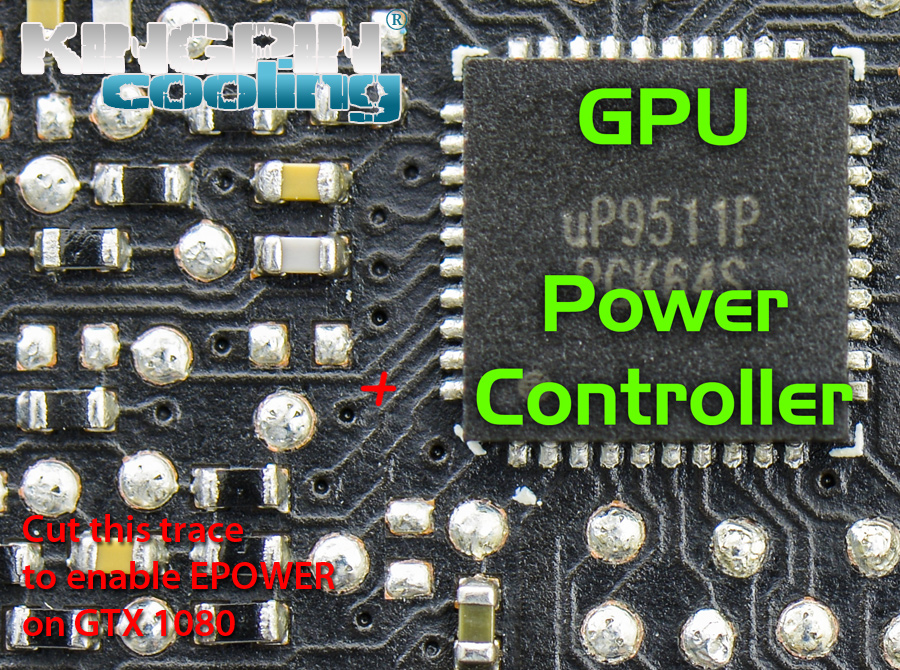
Also make sure that PWR_GOOD on the remaining trace is still activated (held high, +3.3V or +1.8V level when card is powered, with inductors removed). This step required to confirm our GPU is enabled and all it needs is actual power output from the EPOWER to be working again. If PWR_GOOD is still equal to zero, you may need to solder small 1.0...4.7 KOhm resistor to nearest +3.3V point. You can trace +3.3V by probing PCIe +3.3V pin and components near VGA's VRM controller with DMM, set to lowest resistance measurement range, such as 200 Ohm.
For more details on which trace is PWR_GOOD (sometimes called *VR_RDY* or *READY*, depends on controller) on specific card try to find datasheet for the specific controller used on your card, or consult with all-knowing Internet.
Memory VRM may also have same PWR_GOOD signal, that can enable/turn on secondary VRMs, such as PEXVDD. Make sure that one is correct as well. If it's not high +3.3V/1.8V when card is powered on, add a pull-up resistor as described above. You must have all rails operational at power on, otherwise GPU will not start.
STEP 4 - Expose copper plane for ground and power on target device Now we removed onboard inductors, ensured correct level of PWR_GOOD signal and ready to proceed for additional copper cleaning to get larger soldering area to EPOWER. More surface area between VGA and EPOWER improve connection quality and reduce unwanted parasitic resistance. Do not skip on this step, as even small resistance increase of 10 mOhm can cause significant voltage losses and issues at high current levels. Modern GPUs can easily sink currents over *200-400 A* under extreme overclocking conditions, or even more in short peaks under heavy load!
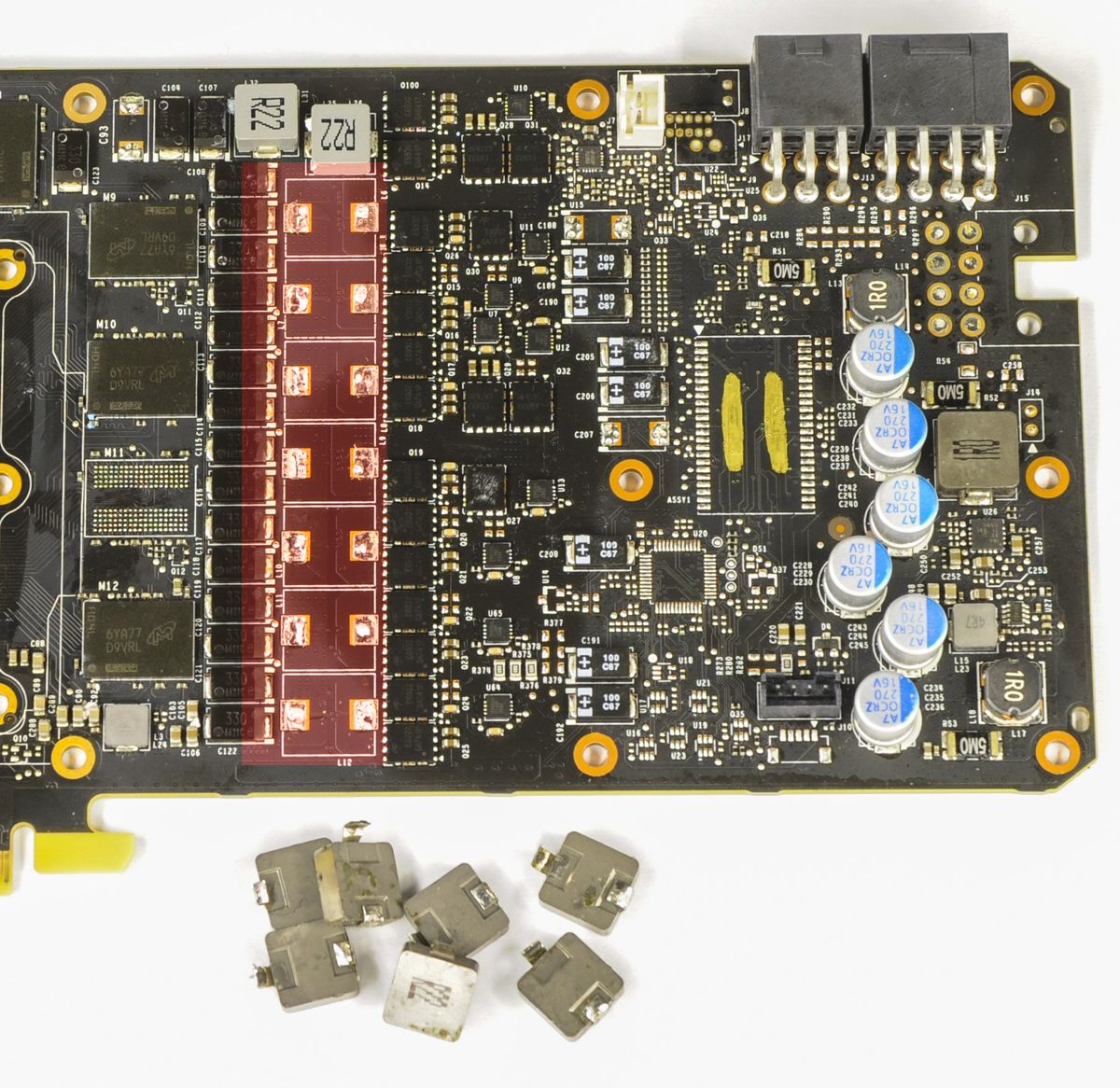
Solder mask is hard coating on the PCB surface that protects outer copper layer and provide electrical insulation to avoid shorts. On VGA this mask often colored black, but it can be different colors. Mask coating is chemically and mechanically robust, so typical solvent such as acetone or IPA will not be able to remove it.
Easy way to remove mask is use mechanical tools to remove thin layer, exposing bare copper metal for soldering. Inspect the area carefully, to ensure there are no isolated via (PCB pad with metallized thru-hole drill) for other signals. We need expose copper connected to GPU power. Best area to start with is outputs of the inductors (left pad on photo above).
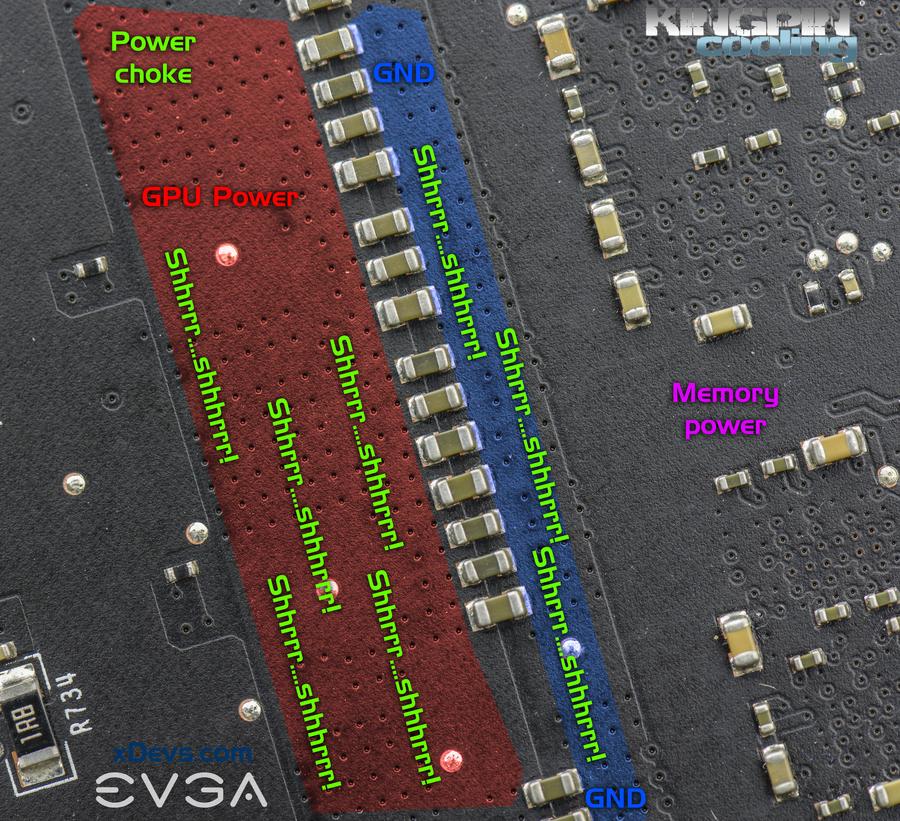
You can use any tool suitable for scratching etc. While it's OK to do so with sharpie, it's possible with careful use of small grinder, such as
Proxxon FBS 115/E with sandpaper cylinder tool on it.
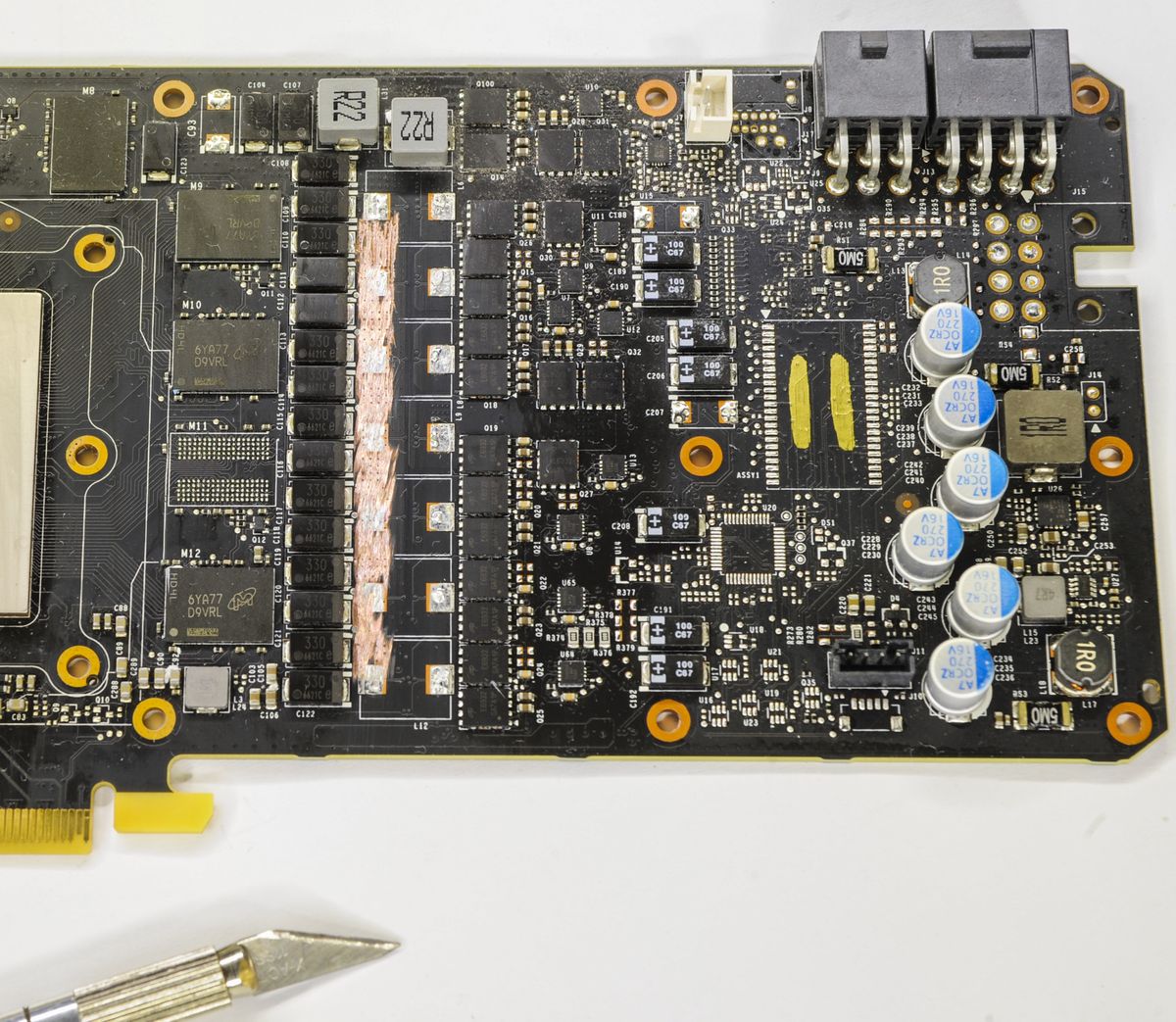
Take care not to expose or short any other traces on PCB, or you will need to repair broken connections. Use minimal speed and avoid applying force, to reduce risk of knocking off nearby PCB components damage or going too deep into PCB layers. After some "shhrrr-shhrrr" action, you should have nice and shiny clean copper surface on power plane, ready for soldering.
If you connecting memory power to EPOWER, expose memory copper plane same way.
STEP 5 - Solder the EPOWER down to the card Good rule to follow: one pair of wires (VCORE+GND) per each 10-15A of estimated current. For simple VGA with 2-3 phase VRM best to use 4-8 wire pairs. For high-end VGA should be no less than 12-16 wire pairs. Top GPUs like GK200, GM200, GP102 you must use as many pairs as possible physically or solid copper planes.
Solder thick (AWG10-AWG12) wires or 0.5-2mm solid copper plate from EPOWER V GND to ground areas on card and VCC points to power plane. Ground can be probed by DVM in resistance mode, by reading less than 0.1 Ohm between outer metal shells of DVI/HDMI connectors. Use the relative measurement to shorted probes, to null the resistance of the probe leads. If your DMM does not have the relative measurement mode, just short probes together in lowest resistance range and subtract resulting reading later from the actual measurement to obtain true resistance on PCB. Use sharp and clean probes for good contact.
In the end result you may end up with photo next:
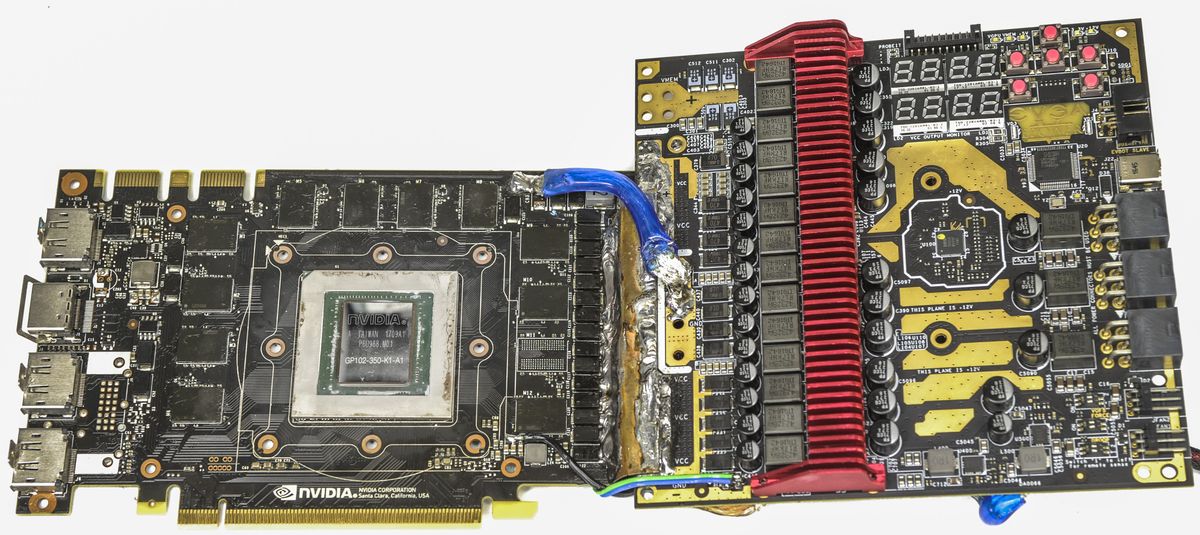
Note solid copper connection for the VCORE output between EPOWER and VGA card. Blue AWG8 cable provide additional ground connection. There are more of these wires between EPOWER and the card.
Keep in mind that once you soldered EPOWER on the card, you will lose access to the front side of the reference PCB. This means adding any reworks or modifications in area under EPOWER would be extremely difficult. So add wires and other modifications, like memory mod, power mods BEFORE you solder EPOWER. After connecting EPOWER V to GPU always check the resistance between power and GND to ensure there are no shorts. Normal resistance range for a GPU is 0.4-10 Ohm depending on GPU, for memory – 10-200 Ohm. If you get very different resistance readings, you card is likely borked and game is over. Well, not really, you just need to find short between power and ground and fix it.
Same process applies to memory power, if you use it from EPOWER. If wires and connections between VCORE and VMEM outputs are too close, check the resistance to make sure there is no short between power rails.
Also I have collection of resistance measurements on legacy graphic cards, listed
here.
STEP 6 - Final check and first power on After obtaining good results on resistance check, you can go ahead with final checks and mounting cooling system on the GPU. Insulate PCB from water condensate by preferred way, same as you would do with normal LN2 session. Keep moisture away from the EPOWER V card and ensure that there is no direct contact with frozen areas on target device.
EPOWER V card also requires airflow under heavy load conditions, get some 80-120mm sized DC fans ready. EPOWER provide two 3-pin FAN connectors, each can provide 3 Amps at +12 V.
Install zombie card into the PCIe slot, make sure no metal parts touching the EPOWER PCBA. Connect PCI-Express power 6-pin/8-pin cables to BOTH EPOWER V card AND videocard. This will provide power and ground to the VGA, as most cards still need to have +12V present for auxiliary circuits and detection logic to work properly. Default startup voltage for EPOWER rails is +0.9 VDC for VCORE and +1.35 V VMEM. Preset voltage levels fit modern GPUs like 980/980Ti/1080/1080Ti/Titans.
Now turn system on, and check all the voltages. If power on voltage is OK and there is no smoke coming out of nowhere. but system does not detect videocard – make sure *PWR_GOOD* signal from onboard VRM controller on videocard is isolated, and it's GPU side is indeed +3.3V. If it's low (0V) GPU will be kept in reset (because onboard power is not used – it’s fault state for it).
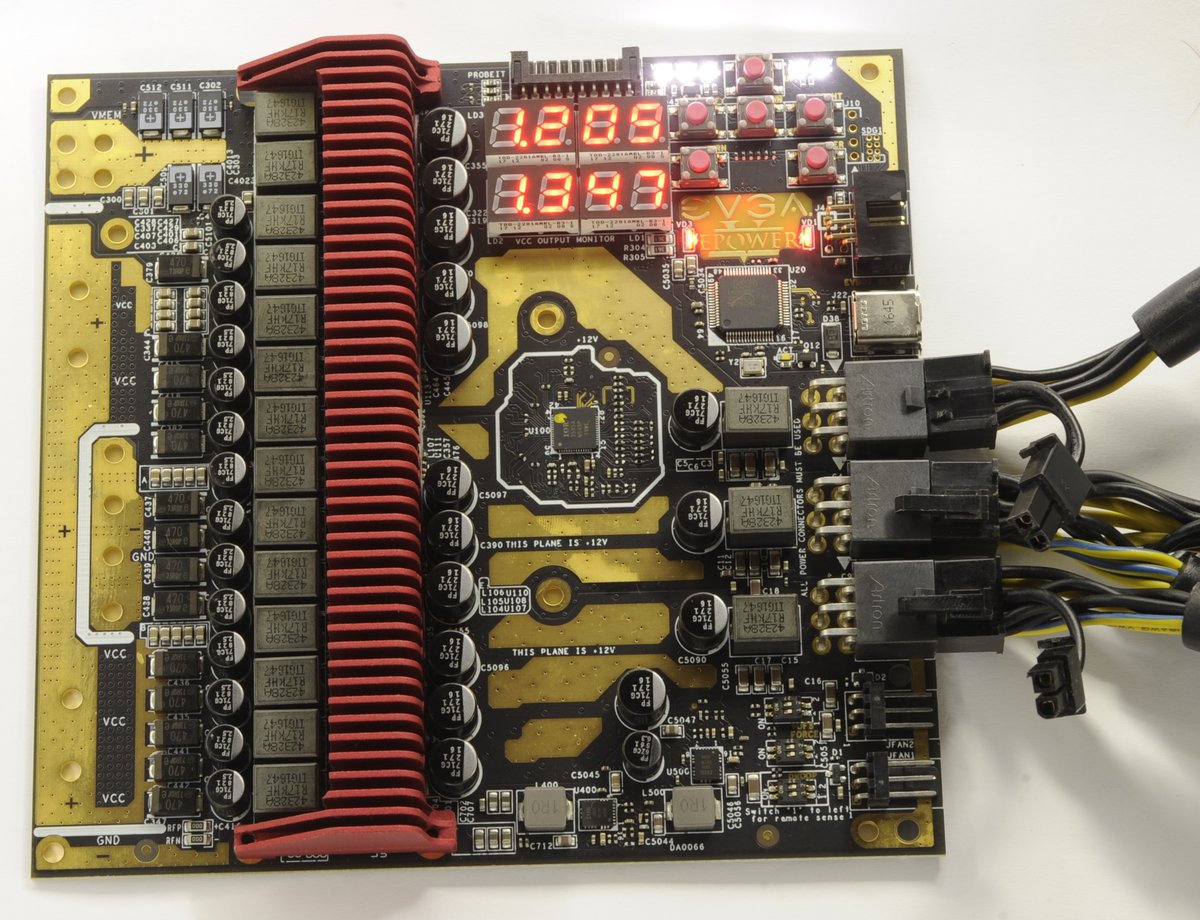
EPOWER does a quick self-check every power on, and then automatically switches outputs ON. If everything OK, it will display current output voltages on LED display, like displayed on Image 25.
EPOWER output voltage control Voltage control is easy and straight-forward. There are six buttons on top right corner of the board, which allow to perform all essential adjustments.
*
UP - Increase value by one digit.
*
DOWN - Decrease value by one digit
*
LEFT - Move cursor 1 position left, highlighted by decimal dot on display.
*
RIGHT - Move cursor 1 position right, highlighted by decimal dot on display.
*
ENTER - Apply new value to EPOWER output
*
RETURN - Reset voltage to 0.9 V / 1.35 V levels.
Both displays are controlled by same buttons, cursor for selected digit will automatically switch once you press LEFT (or RIGHT) in most significant digit of the previous display.
Voltage is applied immediately on ENTER keypress, but return to monitoring mode (when both VCORE and VMEM actual voltages are shown) will occur after few second delay.
Monitoring mode is also indicated by red color for LEDs near EPOWER logo. In setting mode color change to green.
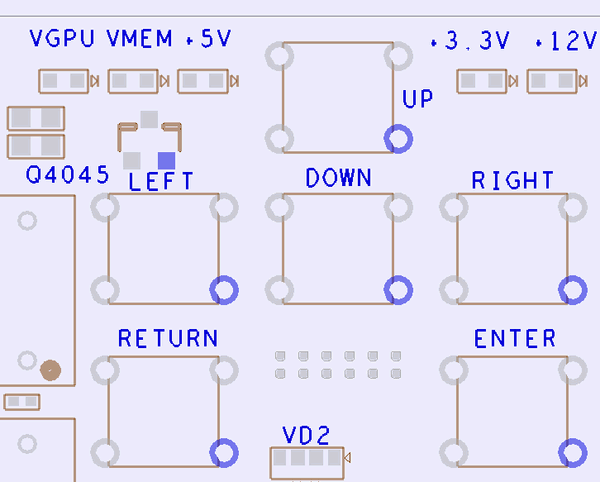
Allowed output voltage range for each rail shown in table below:

These values are valid for the default condition out of the box, measured at the output of the EPOWER V card.
Hardware monitoring options 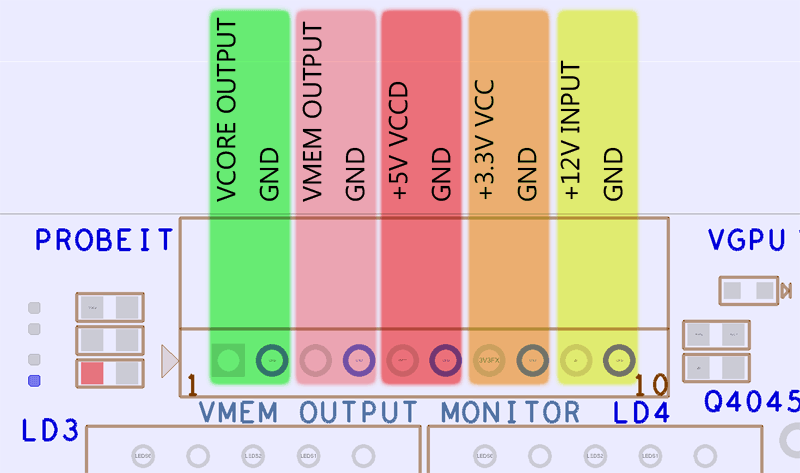
You can use ProbeIt adapter from EVGA Dark motherboard or Kingpin Edition VGA to your usual multimeter probes, or in case you want to have custom cable connection to your specific meter, you can grab connector separately, for example
here from Digikey.com. You will also need
these contacts. If you want less pins (for example only 4 to monitor GPU and MEM voltage) you can get needed housings
right here .
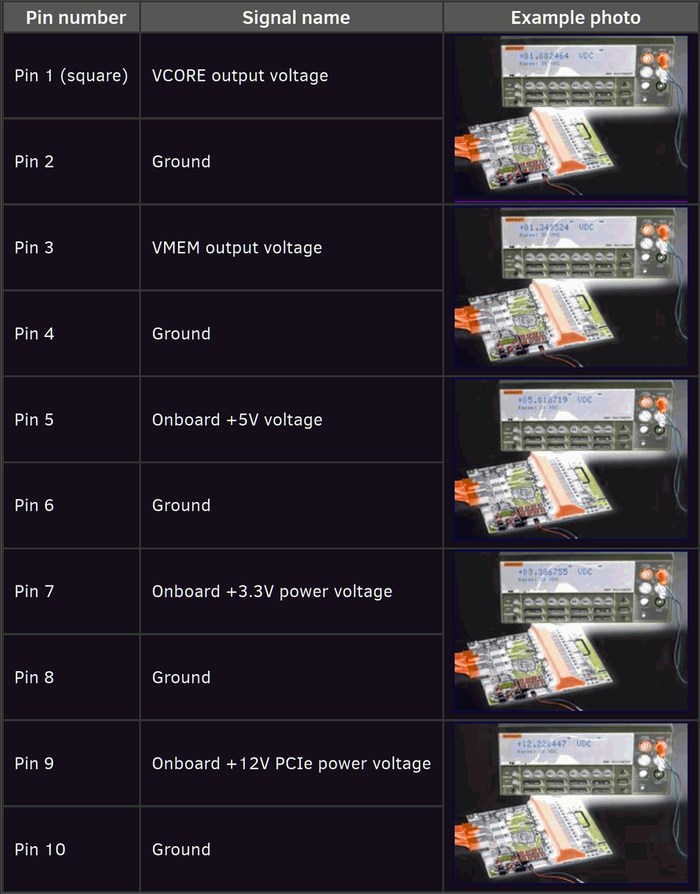
Pinout for this header follows other EVGA OC targeted projects, and shown in Table 4. All voltage outputs from ProbeIt heaters are protected by onboard fuses to ensure safe probing. Same pin definition legend is printed on the bottom side of the EPOWER board.
Also five white LEDs near the PCBA edge allow to monitor the voltage health in realtime. Their definition and function is same as older Classified/KINGPIN cards. If any of the LEDs not on, the voltage rail is absent and system/EPOWER may require troubleshooting.
Onboard switches to control EVGA EPOWER V settings Set of three dual-position switches control advanced features, such as fixed voltage offset, VRM protection override and remote sense function.

Top to bottom they are labelled *VOFS*, *FORCE* and *DROOP*. Factory default setting for all switches is *OFF*, with slider position to the right side. Status and function map for all these presented in table below. Different switch functions can also be used in conjunction.

Voltage increase method is bit different to software or onboard EVBOT override control as an offset is applied at any programmed voltage. It could be useful if you wanted test little bit extra voltage for experiment, without changing programmed setting. Each offset VOFS switch position at ON will add +80 mV, so both will give +160 mV.

Second switch, marked green on Image 28 is for protection override, and would rarely be needed for typical LN2 overclocking. If you suspect that power loss occur due to OCP (which is set really high on EPOWER V), you may try to toggle FORCE switch position to ON and back to OFF to attempt a power reset.
Last, but not least *DROOP* switch. Default "OFF+OFF" setting tells controller to regulate voltage to the programmed value right at the EPOWER board, without taking any loading into account. Let's imagine simple example, VCORE programmed to 1000 mV. With this setting EPOWER's VRM controller will continuously monitor output voltage at EPOWER and adjust switching operation of PowIRStages accordingly to get matching 1000 mV. So the whole system forms a closed feedback loop that maintains stable output. This also mean that VRM controller does not "see" the loading, so if there is a voltage drop on connection wires and reference board PCB equal to 100mV, actual GPU core will get only _1000 mV - 100 mV = 900 mV_.

Now middle settings with either of the switches set to ON will add spacing between sense points so there will be some impact from loading current. In same example VRM will sense some of voltage drop due to loading, and will attempt to compensate by overshooting the output voltage. So with programmed 1000mV setting you may get actual 1050mV, as 50mV loss was accounted for. As result _1050 mV - 100 mV = 950 mV_, so GPU will get closer voltage to the setting.
Remote sense option for maximum control over voltage drop Remote compensation takes this concept to the extreme end, meaning that VRM will ignore onboard voltage at EPOWER and measure the output voltage for compensation at resistors RFP/RFN. Sometimes it is also desired to have fine control over feedback and voltage control under load. To provide best experience with EVGA EPOWER V, flexible remote voltage sense operation is allowed. To fully utilize remote sensing, you need to desolder these two resistors (they are
0 Ohm SMD1206 shorts). Two resistors are installed on the EPOWER PCB by default, just near the bottom left edge.
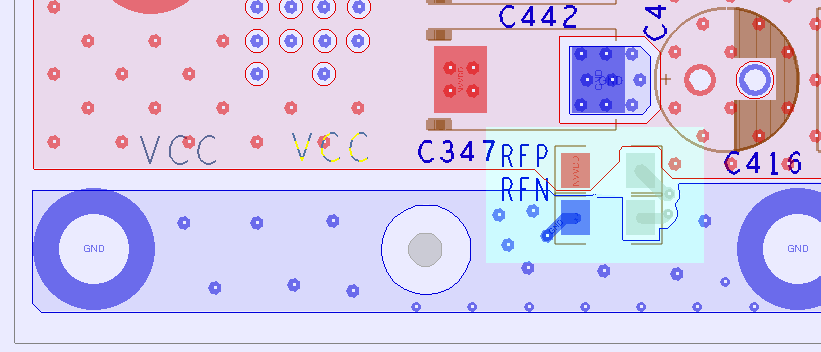
Top resistor RFP is providing positive (+) signal to the VRM controller (gray pad on photo above), while symmetrical RFN is providing negative return (&minus

. To compensate on remote location, connect twisted cable (for example two wires from Cat6 Ethernet cable) and solder them to the points on the reference board attached to EPOWER. Maintain correct polarity, meaning that positive VCORE connection must be connected to RF[*P*] gray pad, and nearest GND return must be connected to RF[*N*] gray pad. As result any voltage droop between EPOWER and sense points would be eliminated by the output overdrive. Sense wire is visible on the Image 24 presented above in this article.
For example, to completely eliminate voltage droop you can route sense wires right to the capacitor + and - pins in area behind GPU on back side.
* Remove RFN and RFP zero ohm (short) resistors
* Solder twisted wire pair to right points (gray pads) of RFN and RFP
* Connect RFP wire to +Vcore on VGA copper plane point
* Connect RFN wire to -GND on VGA copper plane point
Make sure your sense wiring is correct, and right RFP pin is connected to positive sense point on target device (+Vcore). Right *RFN* must be connected to negative sense point on target device (GND). If connection get broken output voltage will be unregulated, which can damage your graphics card or/and EPOWER! In same example as above math calculation with look like _1100mV - 100 mV = 1000 mV_. This meaning that GPU will have same voltage delivered as the programmed setting. If you connect to different locations +/− on reference PCB, you can get effect somewhat in between, with just medium droop compensation. Experiment on your specific setup to find what gives best overclocking results, as there is no universal rule that match every GPU.
Remote sense function can help to mitigate issues due to smaller/weaker connection between EPOWER and VCORE, but it must be applied with care, as there are limits when compensation cannot work reliably anymore. In typical setups VRM can handle around 250mV maximum of voltage droop between EPOWER and sense point. If actual voltage loss is larger, you must add more wires/copper between boards.
Switches can be adjusted any time and work separately from digital controls, due their hardware function nature.
Firmware update procedure and available firmwares As EPOWER target audience is usually experienced overclockers, firmware upgrade procedure is available now to provide even greater control on EPOWER functionality. Firmware update workflow shown in list below:
* Connect all three 6-pin PCIe Power plugs from PSU.
* Connect EPOWER interface port USB Type-C to your Windows-computer.
* Extract contents of *firmware .zip* archive to empty directory.
* Run DFUAPP.exe tool. This tool has simple GUI to allow download and uploads of the EPOWER firmware.
* Hold RETURN key and power on the PSU with EPOWER connected.
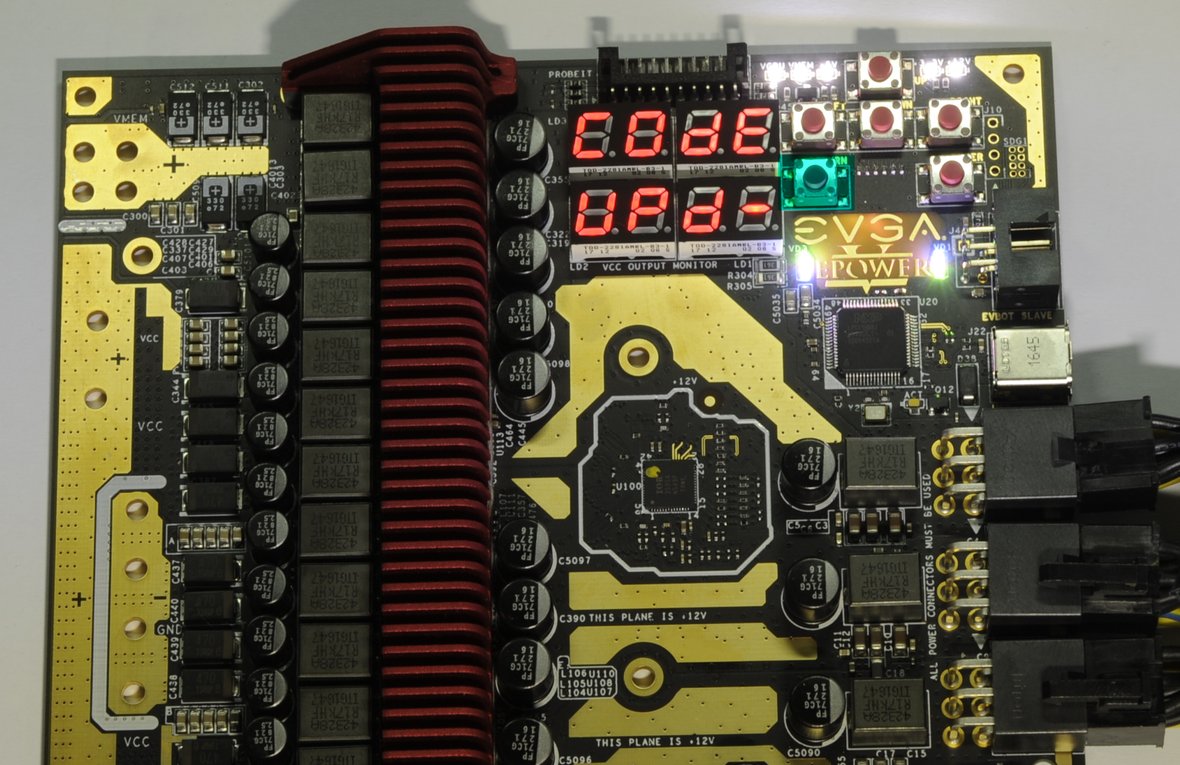
EPOWER should show *CODE UPD-* message on the LED display, and DFU application should be able to detect connected EPOWER
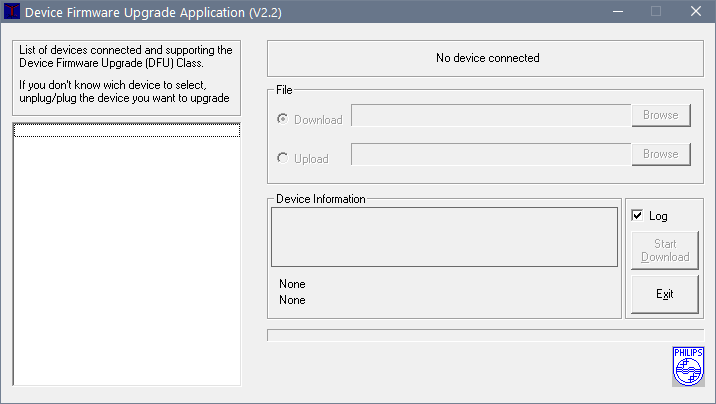
* Select firmware *.bin* file from the file in Download section.
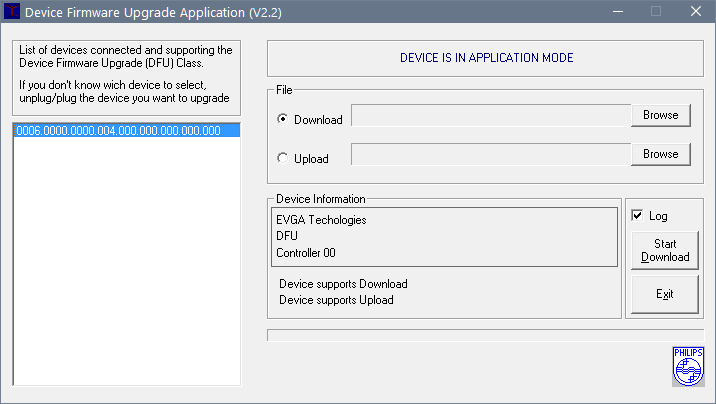
* Press "Start Download" button to update code in EPOWER with selected binary file.
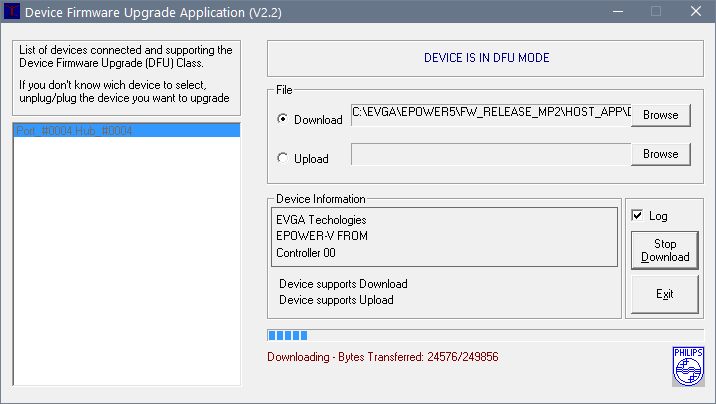
Now DFU tool will upload the code into EPOWER controller. During the process you will see *CODE UPD-* LED display message flashing, that is expected.
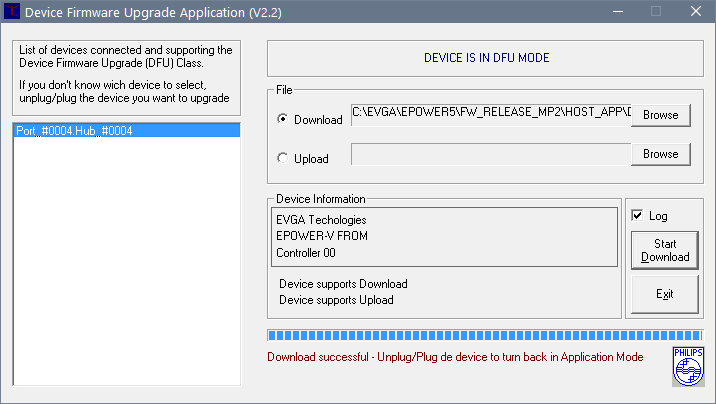
Once completed, you will be greeted with "Download successful" message.
* Unplug USB cable and power cycle the EPOWER.
Available firmware list provided in list below.
* EVGA EPOWER V, Rev.52a firmware, best for GTX 1080/1080Ti/Titan X(Pascal), default 0.9 V / 1.35 V =
RAR SFX-archive. Checksum CRC32 is 2DFECD54.
* EVGA EPOWER V, Rev.52b firmware, best for GTX 980/980Ti/Titan (Maxwell), default 1.2 V / 1.5 V =
RAR SFX-archive. Checksum CRC32 is 4FB21602.
There are no performance difference between firmwares, it's just default voltage settings.
DFU tool allow any direction upgrade, both from newer version to older, and from older to newer.
Conclusion and feedback Hope this will help to get better overclocking and world records out of your hardware, with no more power delivery issues or limitations. If you find errors or have issues using your EVGA EPOWER V, feel free to leave a comment here or in discussion thread here.
PDF-version of the guide.